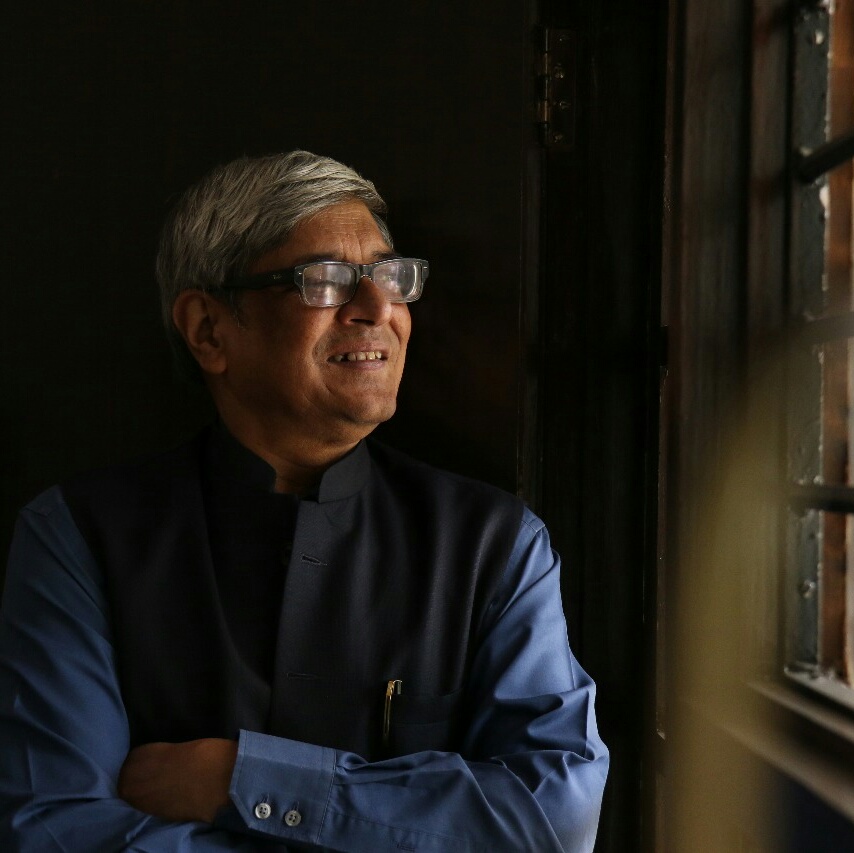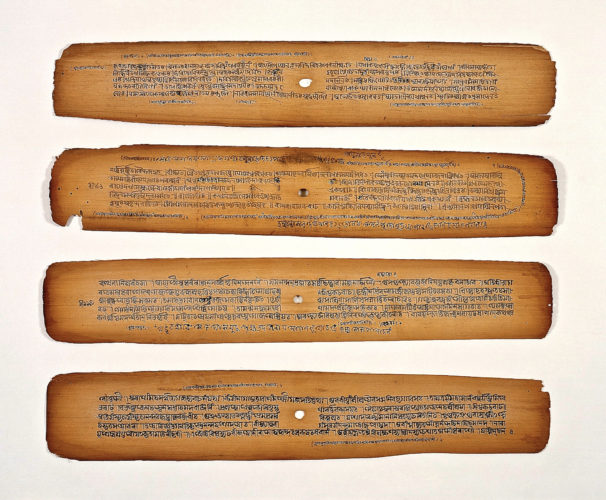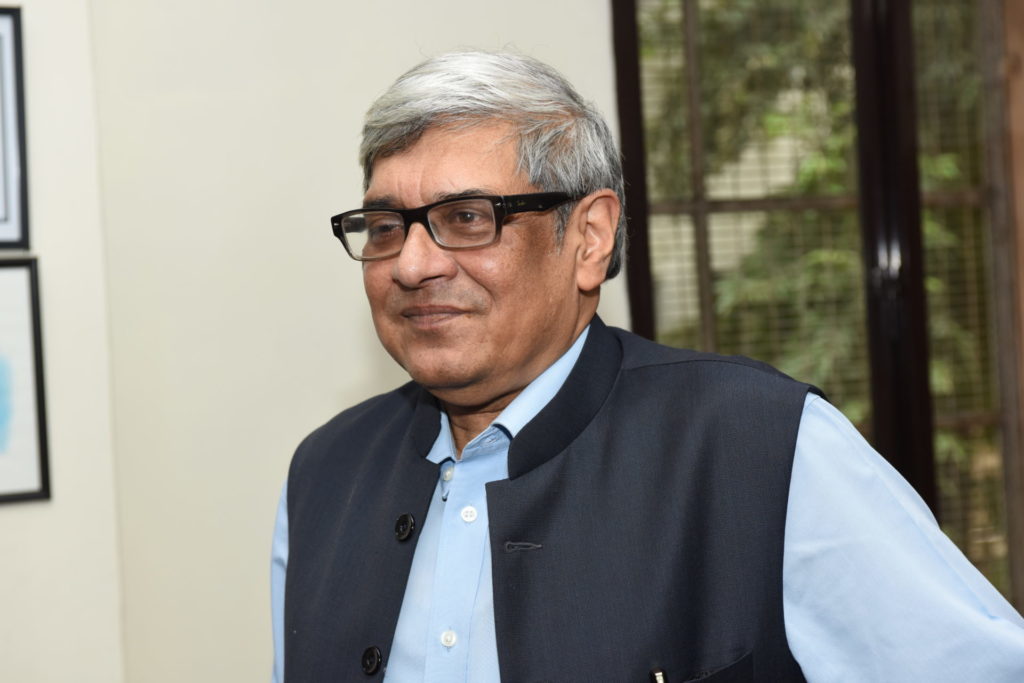
As is only to be expected, ink is older than pens, not to speak of fountain pens. Across old civilizations, India, Egypt, China, Rome, ink was used, based on lamp-black and pigments with plant, animal and mineral origins. The history of those experiments and innovations is often forgotten. Something like D. C. Sircar’s work deserves far better dissemination.[1] I don’t think people generally remember Dineshchandra Sircar (1907–1985), except those who are historians and epigraphists. Those interested in fountain pens should read his work on Indian epigraphy. Let me quote.
“Palmyra leaves, separated from the lengthwise joint in the middle and cut at both ends according to the required size, were used for writing letters as well as manuscripts of literary works in Sanskrit and other languages…In North India, the general practice was to write on the leaves with pen and ink, while, in the South, the letters were incised on the leaves with a sharp-pointed needle and were made black by besmearing ink on the writing.” In Sanskrit, the most common word for ink is “masi”. It was made from lamp-black or charcoal, mixed with gum, sugar and other ingredients. More specifically, the process was a bit like the following, for making permanent and non-washable ink. The resin of the pipal tree was ground and mixed with water. This was boiled and mixed with ground borax and lodhra, finally strained with cloth. To impart a black colour, lamp-black was added. Mixing of vermilion make the ink red. Other hues of ink were green, yellow, gold and silver. “The writing on cloth and birch bark referred to by Nearchus and Curtius suggests that ink was used by the Indians in the 4th century B.C. The word lipi, from the root lip, found in Panini’s grammar (c. 5th century B.C.) and the inscriptions of Asoka (c. 272-232 B.C.) points to the same conclusion.”

That’s the ink. What was the ink applied with? “Lekhani (literally ‘the instrument for writing’) is a general name for the stylus, pencil, brush, pen, etc. Varnika, mentioned in early Indian literature, was a wooden pen, pointed at the end without a slit. It was used by young learners at the elementary schools. Isika was originally a pen made of reed or bamboo branch. It was used by the copyists of manuscripts.” What is an Indian word, in any of the Indian languages, for a pen? I have asked various people this question. None of them mentioned varnika or isika. A few, with some exposure to Sanskrit, did say lekhani.
The quill pen was not as ubiquitous in India, as it was in other parts of the world. This statement of course needs to be nuanced. The writing instrument is a function of what one is writing on. If one is writing on parchment or vellum, both of which are animal skins, a quill pen might be better, but not necessarily if one is writing on bark, cloth or palm leaf. In Europe, quill pens took off because the writing material became parchment or vellum. Conversely, as the writing material became paper made from wood pulp, the quill pen declined in importance, though some calligraphers still swear by it.
No one can possibly date the use of a quill pen. In Sanskrit, the word “patatri” means a bird, or something that flies, from the verbal root “pat”, meaning “to fly”. That word is cognate with the Latin word “penna” or “pinna”. This word means the wing on the body of a flying creature, or a feather. In other words, when we use the word “pen”, we implicitly acknowledge a pen’s antecedents in a quill made from a feather. Whenever quill pens are mentioned, Isidore of Seville (6th and 7th century CE) is invariably quoted. He wrote a book called “Etymologiae” or “Origines”, documenting the etymology of various words. In Latin, Isidore of Seville wrote, “instrumenta scribae, calamus et penna: sed calamus arboris est, penna avis”. That’s the bit usually quoted. However, we should quote not just that bit, but everything he wrote about a reed pen or a quill and we shouldn’t quote it in the Latin, but in an English translation.[2] “The scribe’s tools are the reed-pen and the quill, for by these the words are fixed onto the page. A reed-pen is from a tree; a quill is from a bird…The reed-pen (calamus) is so called because it places liquid, whence among sailors ‘to place’ is calare. A quill (pinna) is so called from ‘hanging’ (pendere), that is, flying, for it comes, as we have said, from birds.” The Indian tradition is that of calamus, not penna.
That’s interesting, because many people in India will refer to a pen not as lekhani, varnika or ishika, but as kalam(a). The explanation is there in Dineshchandra Sircar.[3] “The word kalama may have been adopted in Sanskrit from Greek through Arabic. But it is recognised as a Sanskrit word in the Sanskrit-Chinese lexicons of the 8th century A.D.” To reiterate the point made earlier, in India, we traditionally used a kalama (as in reed pen), not pen (as in quill). If we stick to etymology, in India, we should stop using the word “pen” and start to call them fountain kalams.

Bibek Debroy is an economist and was educated in Ramakrishna Mission School, Narendrapur; Presidency College, Kolkata; Delhi School of Economics and Trinity College, Cambridge. Presently, he is Chairman, Economic Advisory Council to the Prime Minister (EAC-PM) and President, Indian Statistical Institute (ISI). He has worked in Presidency College, Kolkata (1979-83), Gokhale Institute of Politics and Economics, Pune (1983-87); Indian Institute of Foreign Trade, Delhi (1987-93); as the Director of a Ministry of Finance/UNDP project on legal reforms (1993-98); Department of Economic Affairs (1994-95); National Council of Applied Economic Research (1995-96); Rajiv Gandhi Institute for Contemporary Studies (1997-2005); PHD Chamber of Commerce and Industry (2005-06); Centre for Policy Research (2007-2015); Member, NITI Aayog, Government of India (Jan.2015 – Jun.2019). He has authored/edited several books, papers and popular articles and has also been a Consulting/ Contributing Editor with several newspapers.
[1] Indian Epigraphy, D. C. Sircar, Motilal Banarsidass, Delhi, 1965. The quotes in this paragraph are from that book.
[2] The Etymologies of Isidore of Seville, translated by Stephen A. Barney, W. J. Lewis, J. A. Beach and Oliver Berghof, Cambridge University Press, 2006.
[3] Ibid.

Amazing as usual from Bibek Sir, the depth of research is always without a parallel.
I pray for your safety.
I love articles and research of Bibek Sir, with your writing(chawm sir) and his research this is worthy of reading…
small correction. all his articles are penned by Bibek Debroy Sir.
Chawm